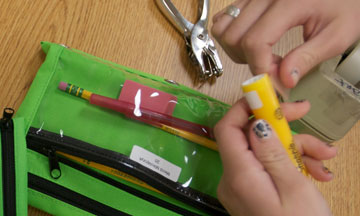
 Diocesan schools continue to boast mostly positive news as they roll into the first quarter of the new year, despite an economy that keeps sputtering and stalling.
Diocesan schools continue to boast mostly positive news as they roll into the first quarter of the new year, despite an economy that keeps sputtering and stalling.
Sandra Leatherwood, assistant to the superintendent, said about a dozen schools have either completed recent renovations, or are in the process.
Some are holding capital campaigns to finance new schools while others are renovating and upgrading what they have.
The most extensive this year was St. Andrew School in Myrtle Beach. (see below)
Along with the current schools, construction plans for two new high schools are also moving forward with permission from Bishop Robert E. Guglielmone.
In Bluffton, Pope John Paul II School has launched its capital campaign. The other school, slated for the Myrtle Beach area and originally named Bishop Baker High School, will launch its campaign soon.
Jacqualine Kasprowski, interim-superintendent, said the name was changed to St. Elizabeth Anne Seton, with blessings from Bishop Robert J. Baker, who is now in Birmingham, Ala.
But the economy is still a factor, and continues to eat away at the enrollment of the 33 elementary and high schools.
According to figures from the diocesan school board, only about eight schools posted student growth. These figures do not include the two private high schools.
Some schools saw big drops of 30 students or more, while others only lost a few. This is a trend that has plagued the diocese since the economic recession began about four years ago.
During the 2007-08 school year, the diocese had a high of almost 6,000 students.
Since then, that figure has dropped to about 5,100.
“We have seen a lot of families who haven’t been able to make ends meet have to leave,” Kasprowski said. “We have to have faith that the economy will take a turn for the better.”
In the meantime, she said they will hold the course and make sure diocesan schools consistently deliver Catholic education of quality.
In fact, a recent study published by Fox News shows that Catholic schools deliver more per dollar than public schools.
According to their statistics, the average SAT score for Catholic school students is about 42 points higher than public school children.
And they do it for about $2,000 less.
“We’re great at stretching a dime into a dollar,” Kasprowski said.
The interim-superintendent also noted that Catholic education offers certain intangibles, like respect and discipline, as part of the experience.
Recently, the diocese secured a St. Elizabeth Anne Seton tuition assistance grant for $100,000. Officials hope that will help parents who are struggling, Leatherwood said.
